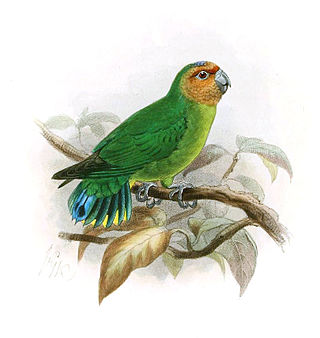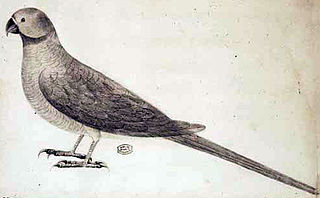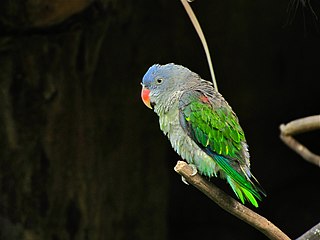
Pygmy parrots are the smallest members of the parrot order. The six species of pygmy parrots are all in the genus Micropsitta, which is the only genus in the Micropsittini tribe.

Newton's parakeet, also known as the Rodrigues parakeet or Rodrigues ring-necked parakeet, is an extinct species of parrot that was endemic to the Mascarene island of Rodrigues in the western Indian Ocean. Several of its features diverged from related species, indicating long-term isolation on Rodrigues and subsequent adaptation. The rose-ringed parakeet of the same genus is a close relative and probable ancestor. Newton's parakeet may itself have been ancestral to the endemic parakeets of nearby Mauritius and Réunion.

Members of the parrot genus Psittacula or Afro-Asian ring-necked parrots, as they are commonly known in aviculture, originate from Africa to South-East Asia. It is a widespread group with a clear concentration of species in south Asia, but also with representatives in Africa and the islands of the Indian Ocean. This is the only genus of parrot which has the majority of its species in continental Asia. Of all the extant species only Psittacula calthropae, Psittacula caniceps and Psittacula echo do not have a representative subspecies in any part of mainland continental Asia. The rose-ringed parakeet, Psittacula krameri, is one of the most widely distributed of all parrots.

The Moluccan eclectus is a parrot native to the Maluku Islands (Moluccas). It is unusual in the parrot family for its extreme sexual dimorphism of the colours of the plumage; the male having a mostly bright emerald green plumage and the female a mostly bright red and purple/blue plumage. Joseph Forshaw, in his book Parrots of the World, noted that the first European ornithologists to see eclectus parrots thought they were of two distinct species. Large populations of this parrot remain, and they are sometimes considered pests for eating fruit off trees. Some populations restricted to relatively small islands are comparably rare. Their bright feathers are also used by native tribespeople in New Guinea as decorations.

The echo parakeet is a species of parrot endemic to the Mascarene Islands of Mauritius and formerly Réunion. It is the only living native parrot of the Mascarene Islands; all others have become extinct due to human activity. Two subspecies have been recognised, the extinct Réunion parakeet and the living echo parakeet, sometimes known as the Mauritius parakeet. The relationship between the two populations was historically unclear, but a 2015 DNA study determined them to be subspecies of the same species by comparing the DNA of echo parakeets with a single skin thought to be from a Réunion parakeet, but it has also been suggested they did not constitute different subspecies. As it was named first, the binomial name of the Réunion parakeet is used for the species; the Réunion subspecies thereby became P. eques eques, while the Mauritius subspecies became P. eques echo. Their closest relative was the extinct Newton's parakeet of Rodrigues, and the three are grouped among the subspecies of the rose-ringed parakeet of Asia and Africa.

The Australian king parrot is a species of parrot endemic to eastern Australia ranging from Cooktown in Queensland to Port Campbell in Victoria. Found in humid and heavily forested upland regions of the eastern portion of the continent, including eucalyptus wooded areas in and directly adjacent to subtropical and temperate rainforest. They feed on fruits and seeds gathered from trees or on the ground.

The Seychelles parakeet or Seychelles Island parrot is an extinct species of parrot that was endemic to the Seychelles in the Indian Ocean. It was scientifically named Palaeornis wardi by the British ornithologist Edward Newton in 1867, and the specific name honours the British civil commissioner Swinburne Ward who procured the specimens that formed the basis for the description. It was found on the islands of Mahé, Silhouette, and possibly Praslin. Ten skin specimens exist today, but no skeletons. Though the species was later moved to the genus Psittacula, genetic studies have led some researchers to suggest it should belong in a reinstated Palaeornis along with the closely related Alexandrine parakeet (P. eupatria) of Asia.

Psittaculini is a tribe of parrots of the family Psittaculidae. The subdivisions within the tribe are controversial.

The Mascarene parrot or mascarin is an extinct species of parrot that was endemic to the Mascarene island of Réunion in the western Indian Ocean. The taxonomic relationships of this species have been subject to debate; it has historically been grouped with either the Psittaculini parrots or the vasa parrots, with the latest genetic study favouring the former group.

The Rodrigues parrot or Leguat's parrot is an extinct species of parrot that was endemic to the Mascarene island of Rodrigues. The species is known from subfossil bones and from mentions in contemporary accounts. It is unclear to which other species it is most closely related, but it is classified as a member of the tribe Psittaculini, along with other Mascarene parrots. The Rodrigues parrot bore similarities to the broad-billed parrot of Mauritius, and may have been related. Two additional species have been assigned to its genus, based on descriptions of parrots from the other Mascarene islands, but their identities and validity have been debated.

The Moluccan king parrot is a parrot endemic to Peleng Island, Maluku, and West Papua in Indonesia. It is sometimes referred to as the Ambon king parrot or Amboina king parrot, but this is potentially misleading, as it is found on numerous other islands than Ambon. The male and female are similar in appearance, with a predominantly red head and underparts, green wings, and blue back and tail. Six subspecies are recognised, but only a few of these are regular in aviculture. In the wild, it inhabits rainforests and feeds on fruits, berries, seeds and buds.

Alisterus is a genus of medium-sized Australasian parrots, comprising the Australian king parrot, the Papuan king parrot and the Moluccan king parrot. The three species are respectively found in eastern Australia, Papua, the Moluccas and other Indonesian islands. Predominantly of red and green plumage, the long-tailed parrots are related to the genera Aprosmictus and Polytelis.

Tanygnathus is a genus of parrots in the Psittaculini tribe, of the superfamily of Psittacoidea.

Psittinus is a genus of parrot in the family Psittaculidae. It was formerly considered to include a single species, the blue-rumped parrot, but the Simeulue parrot was split as a distinct species by the IOC in 2021. A 2019 genetic analysis found that the genus Psittacula is paraphyletic with respect to Psittinus, indicating that Psittacula may have to be split into different genera in order to maintain Psittinus as a distinct genus.

Birds of Eden is the world's largest free flight aviary and bird sanctuary, located in Kurland village near Plettenberg Bay in the Western Cape, South Africa. The mesh dome of the sanctuary was built over 2.3 hectares of indigenous forest, and is up to 55 metres (180 ft) above ground level. 1.2 kilometres (0.75 mi) of walkways, about 75% of which are elevated, let visitors see the birds at all levels of the aviary.

The Mascarene grey parakeet, Mauritius grey parrot, or Thirioux's grey parrot, is an extinct species of parrot which was endemic to the Mascarene Islands of Mauritius and Réunion in the western Indian Ocean. It has been classified as a member of the tribe Psittaculini, along with other parrots from the Islands.

The Polytelini tribe belongs to the parrot family Psittaculidae and consists of three genera.

Palaeornis, the epauletted parakeets is a genus of birds named for the red markings on their upper wings resembling epaulettes. Formerly included in the genus Psittacula, this group of birds comprises two species, only one of which is still extant. The genus name was formerly deprecated until it was revived in 2019 by a molecular study on the taxonomics of the genus Psittacula, splitting it into 10 genera, which has been accepted by the IUCN Redlist.


















